They used to race for money. Now, man and horse help heal the human spirit
No longer wanted as race, polo or riding mounts, these horses found a home at EQUAL - where ex-jockeys like Shamri Shamsudin show them how to provide therapy to folks in need.
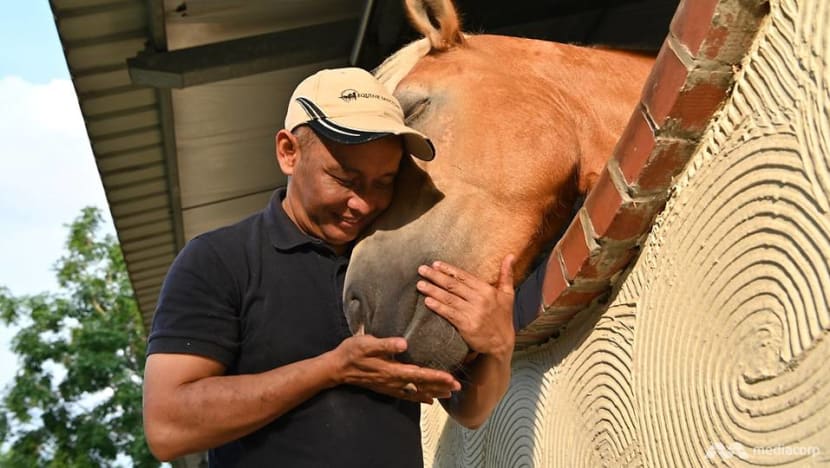
Former race jockey Shamri Samsudin with one of EQUAL's horses, Caterpillar.
SINGAPORE: As a race jockey, Shamri Samsudin’s eyes were set on only one thing: The winning post.
Everything else – from the pounding of hooves, to the shouts of other riders as their mounts jostled past one another – faded into a blur around him, his horse, and the finish line. “When you win, the happiness is something I cannot describe,” he said.
But these days, after almost 30 years on the racecourse, 52-year-old Shamri’s eyes are fixed on a different kind of prize.
It’s the delighted smile of a young child from a troubled family. The spark of wonder in the tired eyes of an elderly nursing home resident, as he strokes a horse’s mane for the first time. The stroke victim who gets up from her wheelchair to kiss an equine muzzle.
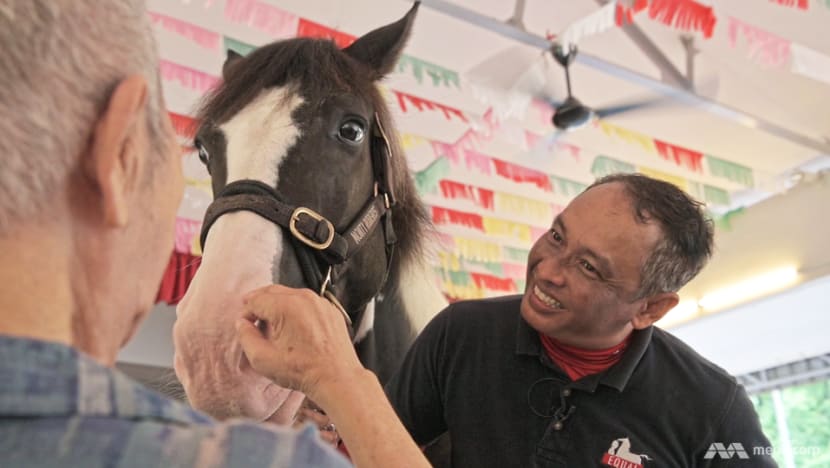
The charity EQUAL brings horse-assisted therapy to youths at risk, families and the elderly in the community, to help them deal emotionally and socially.
But beyond that, it has granted a fulfilling new purpose in life to old jockeys like Shamri – as well as a second chance for horses retired from service as polo, riding or race mounts, and with nowhere else to go.
LIFE AS A JOCKEY
Ever since he was a young boy, Shamri had loved horses. He’d often hang around the old Bukit Timah racecourse after school to watch them.
When he was 16, an instructor at the jockey apprenticeship school noticed the slightly-built young man, and asked if he wanted to be a jockey. “I didn’t think twice,” said Shamri. “I just took the opportunity.”
The training was tough, involving grueling physical work that Shamri likened to army training, and a strict diet to keep his weight between 45kg and 52kg. He was allowed to eat meat only on Mondays, he remembers. The rest of the time, it was salad.
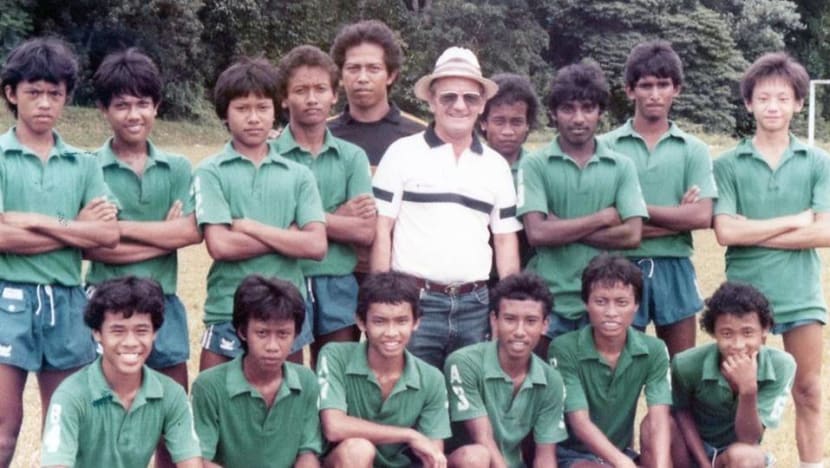
But he liked being close to the horses, and spent huge amounts of time with them to understand their characters and personalities. Part of his training involved eating and sleeping with the horses.
“We had to develop a bond with them,” he said. “Horses can feel your heartbeat, your smell, if you’re nervous or confident with them.”
And then there was the racing. He remembers being at one with his mount, how his blood surged exultantly when they flashed past the post first, the adulatory roar of the crowd in his ears.
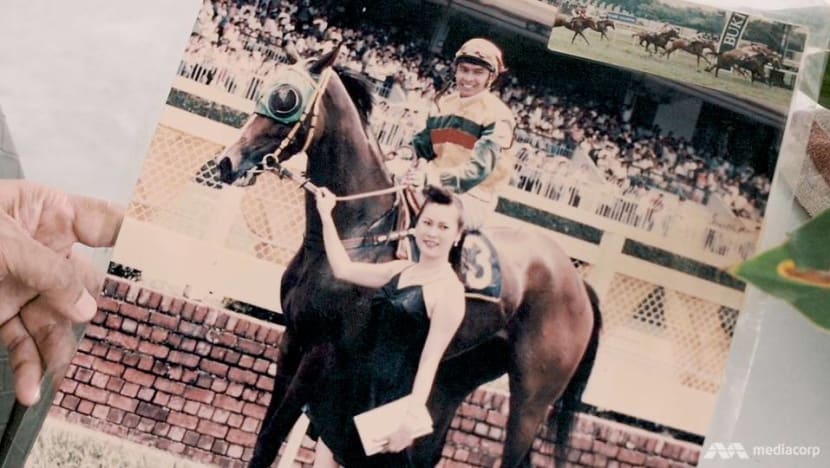
But though Shamri loved the glamour and the adrenaline, as the years passed, the stress and the high-risk environment became too much for him.
The turning point came one day, when right in front of him, a horse collapsed on his best friend during a training run.
“He was paralysed from the waist down,” he said. “It really scared me. I have a family and two kids … any second you can fall and get hurt very badly.
“So I thought about my family, and I decided I had to put a stop (to racing).”

In 2010, Shamri stopped racing horses, but continued working as a track rider exercising the horses until December 2017, when he left the life entirely.
Even though he knew it was for the better, he was crushed. All his life, he had been working with horses. It was as if he had lost his identity.
“Without horses, I didn’t know what to do,” he said.
WHEN HORSES NEED A NEW HOME, TOO
Around the same time Shamri left the track, a racehorse named Galaxy Express was also reaching the end of his racing life.
He was feisty and mischievous, and when he first came to the Kranji course as a young racehorse, Shamri rode him almost every day. “He couldn’t stand still,” the ex-jockey recalled. “He was always curious about what we had in our hand. Always sniffing me.
“He didn’t really concentrate until we put some blinkers on him, then he’d focus on racing.”
When Galaxy passed his eighth birthday in 2018, and was starting to get too old to race, his owner wanted to give him away, said Shamri.
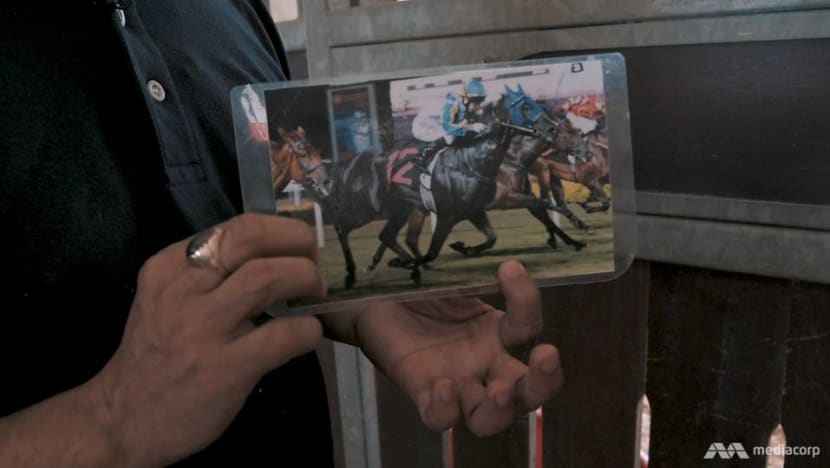
While horses typically live about 25 to 30 years, according to EQUAL’s chief executive Ng Tze Yong, those in the racing line tend to reach the end of their careers by age 5 to 7.
“By that age, you’re on the decline in terms of your horse racing career,” Tze Yong said.
You can’t make the money, you can’t win the races, and that’s when you might be replaced.
“They need to be fed, vet bills need to be paid, they need a stable stall to occupy – all that is money, and if the horse doesn’t generate an equivalent return in economic value, I think it’s very hard for them to keep the horses,” he added.
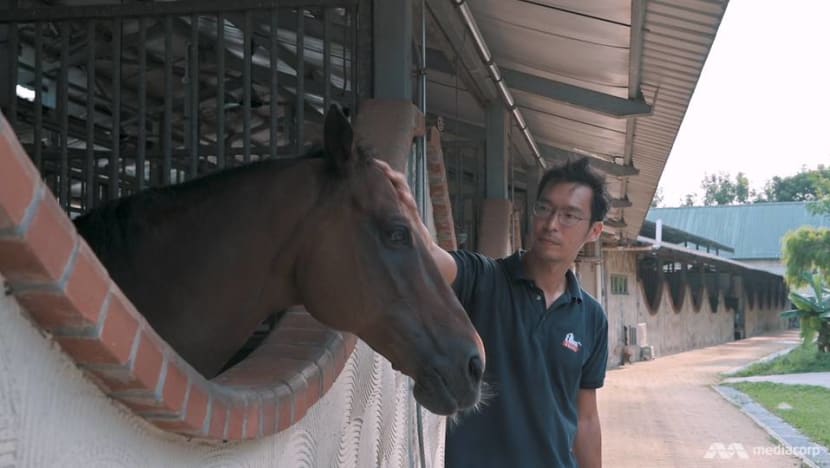
Tze Yong estimates there are about 2,000 horses in Singapore at any point in time, for use in various purposes such as equestrian sports or riding schools.
And about 300 need a new home every year.
“The lucky ones find a home overseas if they have owners wealthy enough,” he said. “But for the others, we don’t really know.”
HOW EQUAL SAVED THEM BOTH
What is known, is that a fortunate few have found a home at EQUAL. Of the charity’s 10 horses, eight are rescues.
There is Kary, for example, an affable, laid-back former riding school horse whose black and white coat makes him resemble a cow. Matahari, a brown mare with a white marking on her forehead, used to be a polo pony.

“If, in the course of our work, we find that we’re able to save these horses rather than buying a new horse, why not?” said Tze Yong.
The charity uses horses to develop social and emotional skills in their beneficiaries. Through grooming the horses and performing activities with them, young and old alike can build their self-esteem, social awareness and confidence.
“It takes a lot of time for people to open up (to other people), and a lot of rapport building,” Tze Yong explained. “But when you work with therapy animals, it’s a lot faster and some people open up a bit more.”
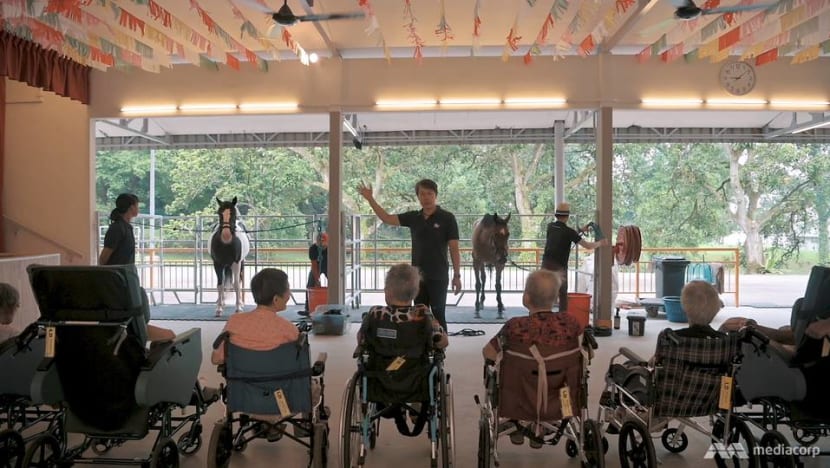
It was this charity that Shamri joined in April 2018.
With no other skills apart from managing horses, he had drifted from one odd job to another. He worked in a friend’s printing shop for a while, then as a banquet manager. As a jockey, he’d easily earned about S$4,000 a month, but after he left, he struggled to hit S$2,000.
Most painfully of all, he missed the horses.
Then one day, an old friend who now worked as an equine manager at EQUAL reached out to him. “He asked me, do you still like horses?” Shamri said. “I said: Of course, it’s in my blood.”
With his instinctive ability to understand the horses, the veteran jockey was a big asset to EQUAL. Said Tze Yong: “We have staff members who used to be counsellors or social workers. But those who used to work with horses are a little harder to come by.”
WATCH: Horses that heal - a second chance at life (6:10)
There are now four former race riders working at EQUAL. As an equine specialist, Shamri takes care of the horses and exercises them.
But, while he started out as a groom, he turned out – with some surprise – to have a knack for relating to the beneficiaries too.
“Sometimes the best counsellors don’t have a counselling certificate. They have a good heart, and have a good listening ear,” said Tze Yong. “And that was what Shamri was to a lot of the youth.
He’s an uncle who’s so kind. and who knows how to speak to these giant creatures – and the youth look up to that.
These days, ‘Uncle Sham’, as he’s affectionately known, has also started bringing the horses out to nursing homes and into the heartlands, as part of EQUAL’s new programmes.

Tze Yong believes demand for these will grow, and he hopes to bring the horses to more schools, nursing homes and HDB estates.
“If we can get more donors, more supporters, we can rescue more horses, we can hire more former jockeys.”
TAMING GALAXY
Just a few months after he started work at EQUAL, Shamri was in for a pleasant surprise: The arrival of his former racing buddy Galaxy Express. “I was so excited, I got to see my baby again,” he said.
The first ex-racehorse to be taken in by the charity, the gelding is now in training to be a therapy horse. But acclimating may take some time, for the racetrack and EQUAL are two different worlds.
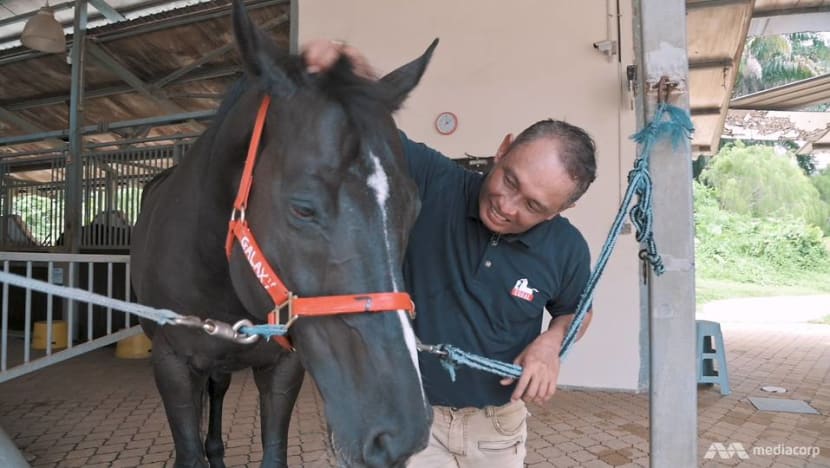
“As a racehorse, you are like Usain Bolt, an elite athlete,” said Tze Yong. “Every day, you eat high energy food, and you’re running kilometres every day at top speed.
"As a therapy horse, it’s the complete opposite.”
Therapy horses require a temperament that makes them suitable to be around humans, such as being calm. EQUAL assesses prospective horses based on a checklist covering aspects of the horse’s appearance, movement analysis, and temperament, including its response to stimulation and how it behaves around people.
Selected horses will then go through a trial period of four weeks where their mental steadiness and aptitude to working with people. In total, it takes about three months to train a horse into a therapy horse.
“Once they are deemed suitable from the trial, we take them in and we commit to working with them,” said Tze Yong.
Learning to relax is a challenge for a horse like Galaxy Express (known simply as Galaxy to the staff) who was bred and conditioned to be always keyed up to compete.
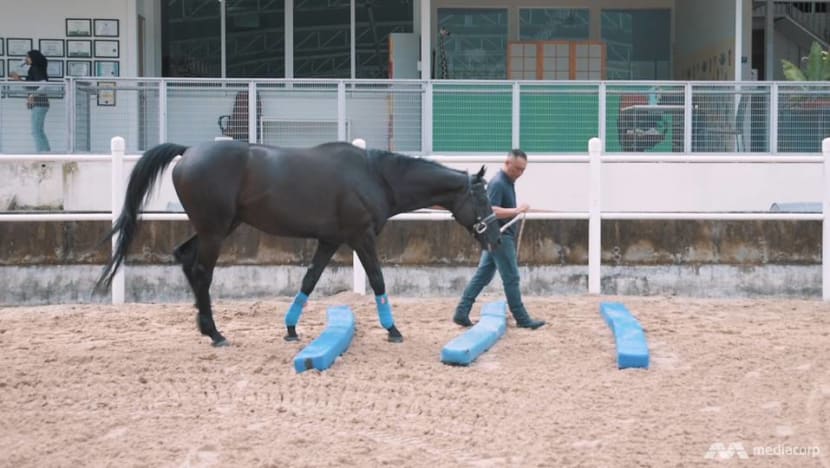
To calm Galaxy down, his workouts are now very different, explained Shamri. Where once an intense morning workout might involve galloping, the treadmill or swimming, these days, Galaxy gets taken on a morning stroll to warm up.
Despite the reduced exercise and a lower-energy diet, the former racehorse still shows flashes of impatience. He pawed the ground as Shamri checked his legs, and resisted Shamri’s efforts to lead him around the stables, kicking out at one point.
“Don’t be stubborn,” Shamri told Galaxy. “I know you’re bored … let’s walk, let’s walk.”
Even the way Shamri talks to Galaxy today has changed. Where he was once stern, today he is a lot more calm and measured in his tone.
“See your mates, they’re riding now,” he told Galaxy as they walked past the other horses being prepared for their programme. “You’ll be there one day.”

THE HORSES THAT HEAL
Meanwhile, EQUAL’s other horses are bringing joy and motivation to the lives of human beneficiaries, such as a group of elderly residents at St Theresa’s Home.
As the float carrying Kary and Matahari trundled up the road, a line of elderly folks in wheelchairs waited expectantly for their therapy session. Some were waving, and there were smiles on their faces.
“Hello horses!” called 61-year-old Valerie De Cruz, blowing a kiss to the horses as Shamri helped with their unloading.
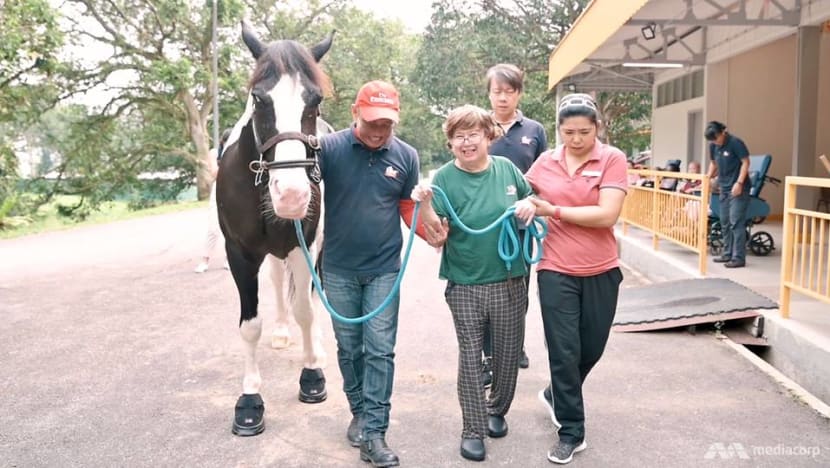
Joshua Chui, the home’s deputy executive director, said: “We try to engage residents with activities every day. But within an hour, most of them are awake just from the pure presence of the horses.”
Interacting with the horses encourages the elderly folks to move and exercise their limbs. Even residents who might lack the motivation to feed themselves will, during the therapy sessions, use their hands to groom the horses.
“When they are with the horses, they are in a good mood, and then we can push them a bit,” said Joshua.
And push the residents, they did. Excited by Kary’s inquisitive sniffing, Valery rallied to get up from her wheelchair with assistance, and actually managed to take a few steps with Kary.
The smile on Valerie’s face was matched only by the one on Shamri’s. “As a race jockey, we went only for the money. But in EQUAL, the goal we want cannot be bought,” he said.
“My heart is full.”
Editor's note: This story has been edited to clarify that there are 2,000 horses in Singapore at any point, and not 2,000 brought in every year.

















